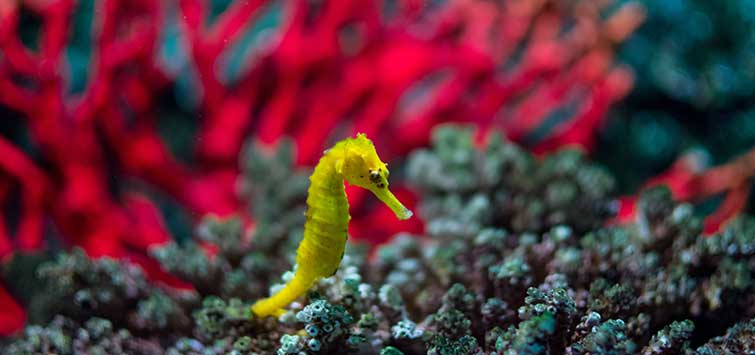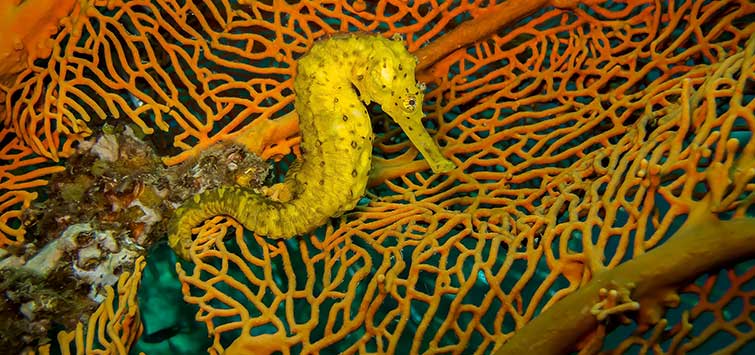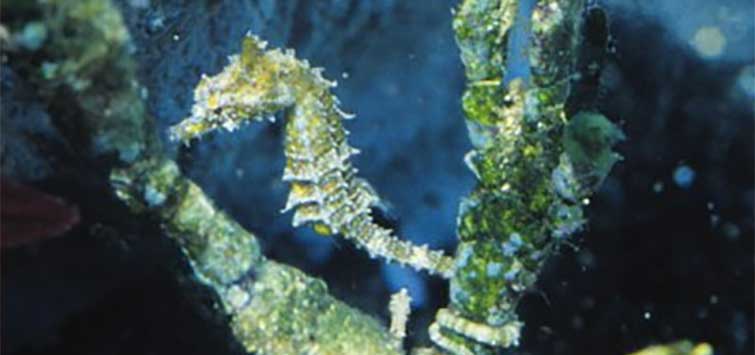A Seahorse Reef, Part One: Reef Compatibility of Hippocampus spp.
Author: Pete Giwojna
Cultured seahorses have become quite popular in recent years, but for reef tanks? As the author explains, they can thrive in these environments with the right setup.
Seahorse Keeping Basics
In recent years, cultured seahorses have become increasingly popular additions to traditional reef tanks with good reason. Seahorses typically thrive in the right type of reef system, which is one that provides them with pristine water quality, plenty of roam to roam, assorted pods to graze on between meals, and a colorful natural setting that makes them feel right at home.
The multicolored coral background will keep them looking their best and brightest, and nothing makes a more breathtaking exhibit than brilliant yellow and orange seahorses lazily gliding amidst the lovely corals, polyps, and gorgonians in a well-established mini reef—much like butterflies adorning a beautiful flower garden.
Lighting the Seahorse Reef
When it comes to lighting, seahorses do not have any special requirements other than the fact that most species prefer low to moderate light levels rather than excessively bright light. They have a corrugated retina especially rich in rods, which gives them excellent visual acuity under twilight conditions and low light levels in general. But this does not mean that they shun bright light, just that they appreciate shady retreats as well as brightly illuminated areas.
In actual practice, seahorses will do well under any type of lighting, from metal halides to power compacts or VHO lighting, to daylight fluorescent tubes to ambient room light—providing shaded areas are available to them and overheating does not become a problem.
Managing Specimens with Different Light Preferences
So don’t scratch seahorses off your list of reef-safe fishes just because you keep corals that require bright light. Hippocampus species are often displayed under metal halide lighting at public aquaria and zoos, as well as in many home reef tanks. Often the reefers will keep the coral and inverts that require strong light at one end of the tank where the metal halides are concentrated. The other end of the tank they will keep shaded to accommodate the seahorses, so that area is reserved for corals that don’t need high-intensity lamps.
Some people will even use pendants as spotlights, focusing the metal halides on the areas with corals that require the strongest light, and leaving other areas of the reef less brightly illuminated. This can produce a very attractive effect similar to sunbeams filtering through broken clouds. You can also provide shaded areas by positioning sections of aluminum foil atop your aquarium; their size and shape can be adjusted to cast shadows where you want them below.
Water Temperature Concerns
My primary concern when using metal halides on a seahorse tank is the water temperature rather than the intensity of the light. Metal halides throw off a lot of heat and most of the subtropical/tropical seahorses do best at temperatures of around 73° to 75°F (23° to 24°C); so avoiding temperature spikes above 80°F (27°C) is very important. If your metal halides consistently keep your reef system in the 80°F range, as is typically the case, be sure to stick to reef-dwelling seahorses that prefer warmer water temperatures, such as Hippocampus barbouri, H. ingens, H. reidi, H. comes, or H. kuda.
You really can’t go wrong no matter what lighting system you chose, as long as you provide both shaded areas where your seahorses can escape from the light altogether and well-lit areas where they can bathe in bright light as they please. You will find that your seahorses will move into and out of the light often, seeking the comfort level that suits them at the moment.
Water Circulation for the Seahorse Reef
Many seahorse keepers are overly conscious of the inactive lifestyle and limited swimming ability of Hippocampus, and have adjusted their flow rates accordingly, resulting in tanks with too little water movement. Don’t make that mistake when setting up your seahorse reef. In actuality, seahorses prefer moderate water movement, including some areas of brisk current, providing there are also sheltered spots and some areas of relatively slack water they can move to when desired. Slack water means comparatively low flow, not stagnant conditions! As with any aquarium, avoid dead spots and stagnant areas in the seahorse tank at all costs.
I have often discussed this matter with professional divers and collectors who regularly encounter seahorses in the ocean, and they report that the horses are frequently found where you would least expect them—well offshore, in relatively deep water, and thriving in areas with strong tides and powerful currents.
Resilience
My point is that as long as slack-water retreats are available, the greater seahorses can tolerate far more current than most folks suspect. What they lack as swimmers is not agility, but rather stamina. They can hold their own against strong currents, but not indefinitely, so low flow areas where they can move out of the current and hold when they want to rest must be provided in addition to good circulation.
Currents and Seahorses
So does this mean the seahorse reef must be devoid of corals that do best in strong currents? No; it just means that the reefkeeper must be cognizant of the above and plan accordingly. When designing a reef tank that will include seahorses, one must anticipate the different ways they might be injured in such a setup and then take precautions to prevent them from coming to harm. The process of rendering your reef system seahorse safe is much like the measures new parents take to childproof their house. Intake tubes for the filters should be shielded, siphon tubes should be equipped with filter baskets or screens, and so on.
For instance, when unpredictable surges and powerful water movement are combined with overflows, there is a risk that seahorses could become pinned against an overflow or even go over it. Therefore, in the seahorse reef, overflows must be baffled and/or screened off, or the water flow should be adjusted sufficiently to prevent that from happening.
Likewise, although seahorses have no problem with strong currents in the wild, in the confines of aquarium it is possible for them to come in contact with stinging corals if they are struck by a sudden powerful wave or surge, or if they are overwhelmed by a strong, unexpected current. The hobbyist needs to take this into consideration when placing water returns and corals in the seahorse reef, particularly if species with powerful nematocysts—such as Euphyllia torch corals or Catalaphyllia elegant corals—will be part of the exhibit. If possible, keep the water currents steady and unvarying so the seahorses can establish holding areas in the sheltered spots and low-flow zones without getting blindsided by unpredictable currents.
Strategic Decor
One good way to accommodate both the needs of corals that prefer powerful currents and the seahorse’s need for slack-water retreats is to create tall rock formations a foot or two down-current from the strongest water flows to intercept and deflect or divert that strong flow of water, thereby creating eddies and slack-water zones where there is relatively little water movement downstream. Seahorses will hold in these low-flow areas when they want to move away from the current, so it’s a good idea to position convenient hitching posts on the lee side of such formations.
Strategic Filtration
Another excellent way to accomplish the same thing is to use small powerheads to create and direct current wherever needed. A properly positioned powerhead can thus bathe your prized Acropora formations in a brisk water stream precisely, without generating too much water movement elsewhere in the aquarium. Just be aware that powerheads can become death traps for seahorses if their intakes are not properly shielded or screened off, and take the necessary precautions. Carefully conceal the intakes amidst the rockwork where they will be completely inaccessible to seahorses, or otherwise shield them, or screen them off with a coarse sponge prefilter.
In short, if your filtration is not turning over the entire volume of the aquarium a minimum of five times per hour, your seahorse setup is undercirculated. A spray bar return positioned above the surface of the water to diffuse the outflow will allow you to achieve turnover rates of 10 or 20 times the total volume of the aquarium every hour without generating too much turbulence or current for seahorses. If you have seahorse-proofed your system properly, there’s really no such thing as too much water movement as long as your seahorses aren’t getting buffeted around by the currents, aren’t spilling eggs during the copulatory rise, and aren’t having difficulty targeting their prey and eating.
Invertebrate Compatibility
The hobbyist who wants to keep seahorses in a reef system must be willing to make some concessions and modifications in terms of the invertebrate inhabitants. In choosing seahorse tankmates, keep in mind the following:
· Avoid any stinging animals with powerful nematocysts. This means fire corals Millepora spp. and anemones should be excluded from the seahorse reef, and any corals with polyps that feel sticky to the touch should be used with discretion and only after careful planning. Small polyp stony (SPS) corals are generally fine, but large polyp stony (LPS) corals should be regarded with caution.
· Water movement and circulation must be managed as previously described. Corals that require powerful surge, wave generators, or overly strong water currents can only be kept if you create slack-water areas the seahorses can retreat to when needed.
· The corals must be able to withstand being used as hitching posts by the seahorses from time to time; that is, they cannot be so delicate that having a seahorse’s grasping tail anchored around them could cause them any harm. For instance, soft corals may retract their polyps when a seahorse perches on them. This can be harmful to their health if it becomes a chronic problem, because such corals rely on the zooxanthellae within their polyps to absorb light and convert it to energy via photosynthesis. Be sure to watch any corals to make sure they are not closed up for extended periods. Normally, they adjust to a seahorse’s presence and unwelcome attention after a while, and remain contracted only briefly after each contact.
· If possible, avoid Tridacna clams and similar bivalve mollusks. Sooner or later a seahorse will perch on them with its tail between the valves and the clam’s powerful adductor muscle will clamp down on it like a vise. At best this will be a very stressful experience for the unfortunate seahorse, since it can be the devil’s own business trying to persuade the stubborn mollusk to release its struggling victim! At worst, it can result in serious injury or permanent damage to the seahorse’s tail.
· Beware of unwanted hitchhikers such as fireworms, mantis shrimp, or Aiptasia rock anemones that may have come in on your live rock unbeknownst to you. These can harm your seahorses. When setting up a reef system for seahorses, it’s a wise precaution to pre-treat your live rock with a hypersaline bath to drive out such pests beforehand, because they can be very difficult to remove or eradicate once they make themselves at home in your aquarium.
As long as the specimens you are considering for your seahorse reef satisfy these requirements, anything goes!
Seahorse-Safe Corals
Soft Corals
Soft corals have very little stinging ability and generally make good choices for a modified mini reef that will include seahorses. This includes most mushroom anemones (corallimorpharians). However, as Soft corals have very little stinging ability and generally make good choices for a modified mini reef that will include seahorses. This includes most mushroom anemones (corallimorpharians). However, Charles Delbeek cautions that the elephant ear mushroom anemone Amplexidiscus fenestrafer is an active feeder on small fish. It envelopes them whole in its mantle and digests them. Small fish of any kind, including seahorses, are not safe with this animal.
Hippocampus also do very well with zoanthids and colonial polyps in general. Other low-light corals that should be suitable for a seahorse reef include genera such as Cynarina, Scolymia, and Trachyphyllia, as well as non-photosynthetic gorgonians such as Subergorgia and Diodogorgia, and perhaps wire corals such as Cirripathes spp. Supplemental feedings of zooplankton may be required to maintain these corals in good health.
SPS Corals
As for the hard or stony corals, SPS corals have tiny polyps that extend out of minute openings in the stony skeleton and generally have weak stings that should not pose a threat to seahorses. Depending on conditions in the tank, SPS corals such as Acropora, Montipora, Pocillopora, Porites, Seriatopora, and Stylophora can be tried freely at your discretion.
Proceed with Caution
The large polyped stony (LPS) corals, however, must be regarded with a little more caution. These include genera such as Catalaphyllia, Cynarina, Euphyllia, and Trachyphyllia that have large fleshy polyps which often have tentacles equipped with powerful stinging cells. The Euphyllia and Catalaphyllia have the most powerful nematocysts among the LPS corals, and they can deliver stings that are stronger than most anemones. However, this does not mean that LPS corals must automatically be excluded from a reef system that will house seahorses.
For example, Charles Delbeek has kept tank-raised seahorses in a seagrass tank with elegans coral Catalaphyllia, and he reports that there were never any problems with the ponies coming in contact with the elegans. Seahorses will usually learn quickly to avoid them, but it is a good idea to monitor the seahorses closely in a tank with LPS corals at first in order to ensure that there are no strong currents capable of sweeping the seahorses against the corals. When considering seahorses for a system with LPS corals, it’s best to stick with reef-savvy species such as H. comes and H. barbouri that instinctively know to keep their distance.
Animals to Avoid
Some invertebrates simply are not compatible with Hippocampus and should be excluded from the seahorse reef. I’ve already mentioned sessile inverts like Millepora, anemones, and clams, as well as motile inverts such as bristleworms and mantis shrimps. Other animals that have no place in a seahorse reef include highly toxic species like sea apples Pseudocolochirus, cone shells (which are so deadly they should not be kept in any home aquarium for any reason), and all cephalopods.
Next time, in Part 2, we will discuss which species of seahorses are best suited for different coral reef systems and how to properly care for them.

.png?h=595&iar=0&w=2781&hash=5FD5E69473BCC22199FBFA2FB71B6033)



